People
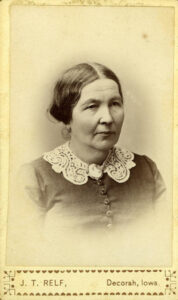
Diderikke Otteson Brandt
A surrogate mother of Luther College students (1865-1885).
Early Years
J. Th. Ylvisaker, in an early history of Luther College, wrote, “A history of Luther College, no matter how brief, would be incomplete did it not make mention of Mrs. Diderikke Brandt.” Diderikke Otteson was born March 9, 1827 in Sande parish on the Christiana fjord in Norway. She was well-educated and traveled Europe extensively in her youth. In 1855, she married Nils O. Brandt and joined him in his pioneer ministry in America. They lived near Ixonia, Wisconsin, from 1856 to 1865.
Years at Luther
The Brandts moved to Decorah in 1865, where Nils became a teacher and pastor at Luther College. Diderikke took it upon herself to become a surrogate mother to the college boys. She organized sewing circles to mend the students’ clothing, raised money for cash-poor students by preparing and selling communion wafers and proved an able hostess for college functions. Her Christmas parties and Sunday teas were times for the students to enjoy themselves, engage in polite conversation, and practice good manners. Diderikke Otteson Brandt fell ill in January of 1885, and passed away on January 21 of that year.
Other information
In appreciation of her contributions to Luther, the alumni association had her portrait painted by Herbjørn Gausta in 1883.
Resources in the Luther College Archives
- Brandt Family — collected materials
- Luther College 1861-1961 by David T. Nelson
Works Referenced
- Nelson, David T., Luther College 1861-1961, Luther College Press, Decorah: 1961.
- Who’s Who in the Luther College Archives
External Resources
Professor and Founder of the Luther College News Service (1919-1966)
Early Years
Chellis N. Evanson was born in 1896.
Years at Luther
Chellis N. Evanson (1896-1983) entered Luther College in 1911, and he graduated in 1918. After spending a year in the United States Navy, he returned to Luther as a history professor in 1919. The same year, Evanson became head of the history department after the death of Knut Gjerset. His teaching style was described as unorthodox and unstructured and he was remembered as a lively and controversial history teacher.
The Luther College News Service was organized by Evanson in 1928 and he worked as the director of the college news bureau from 1928 to 1950. While serving in World War II, Evanson wrote a newsletter called Scuttlebutt, which eventually reached all servicemen from Luther College. He also corresponded with Luther College servicemen, which resulted in the 707 letters found in Evanson’s personal papers. He served on the Luther faculty until his retirement in 1966 and was Dean of Men from 1925-1929. Along with David T. Nelson, Evanson raised money for a war memorial installed in the Main Building at Luther.
After Luther
Evanson remained a strong supporter of the Navy and an active member of the American Legion all of his life. He was also active in the Decorah community as a member of the local school board and many other organizations.
Evanson retired from teaching in 1966. He and his wife, Ruth, continued to live in Decorah. He died in 1983 at the age of 87.
Other Information
The Chellis Evanson papers collection is principally the outstanding collection of correspondence between Evanson and Luther College servicemen and others during the Second World War. The collection is organized into 9 series: Series I. World War II Letter Project Files; Series II. Issues of “Scuttlebutt”; Series III. Letters and Military Records of Luther College Servicemen; Series IV. War Memorial Plaque Files; Series V. Programs and Pamphlets; Series VI. 1936 Concert Band Tour Files and Scrapbooks; Series VII. 50th Reunion of the 1914 Concert Band Tour Files; Series VIII. Biographical Files; Series IX. World War II Memorabilia.
Resources in the Luther College Archives
- Chellis N. Evanson — collected materials
- Luther College 1861-1961 by David T. Nelson
- Stability and Change: Luther College in Its Second Century by Leigh D. Jordahl and Harris E. Kaasa
Works Referenced
- Jordahl, Leigh D. and Harris E. Kaasa, Stability and Change: Luther College in Its Second Century, Luther College Press, Decorah: 1986.
- Nelson, David T., Luther College 1861-1961, Luther College Press, Decorah: 1961.
- Papers of Chellis Evanson
- Who’s Who in the Luther College Archives
External Resources
Early Years
Hjerborn (H.) Gausta (1854-1924) was a Norwegian-American painter. He was born in Vestfjorddalen, Telemark, Norway on June 16, 1854. He and his family emigrated from Norway and settled in Harmony, Minnesota in 1867.
At Luther
From 1872 to 1875, Gausta attended Luther College. After graduating from Luther, he spent several years studying art throughout Europe, spending much of his time in his homeland of Norway. After traveling in the Midwest for a few more years, Gausta returned to Luther to teach art during the 1886-87 school year.
After Luther
After another year wandering in Europe, Gausta returned to Minneapolis, Minnesota where he taught at the University of Minnesota until his death on May 22, 1924.
Other Information
Gausta painted several portraits of people important to Luther College’s early history. He also painted several altarpieces and landscapes. There are at least fifty paintings by Gausta in the Luther College Fine Arts Collection.
Some sources spell Gausta’s first name as Herbjørn.
Resources in the Luther College Archives
- Hjerborn Gausta — collected materials
- Luther College 1861-1961 by David T. Nelson
Works Referenced
- Herbjørn Gausta in the Luther College Fine Arts Collection
- Nelson, David T., Luther College 1861-1961, Luther College Press, Decorah: 1961.
- Papers of Hjerborn Gausta
External Resources
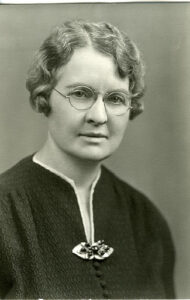
Clara Maude Hoyt
One of the first female faculty members (1936-1958)
Early Years
Clara Maude Hoyt was born in 1890.
Years at Luther
Clara Maude Hoyt (1890-1972), one of only three women appointed before World War II to become official “women of the faculty,” Clara Maude Hoyt joined the music department at Luther College in 1936. While at Luther, she taught voice lessons and was a choir director. She helped organize and became the director of a women’s chorus shortly after women were admitted to Luther. She remained the director of this group for ten years from 1936 to 1946. She was only the third member of the music department faculty when she began her career at Luther. She retired in 1958. She passed away in 1972.
Other Information
A room in Jenson Hall of Music has been named for Hoyt.
Resources in the Luther College Archives
- Luther College 1861-1961 by David T. Nelson
- Stability and Change: Luther College in Its Second Century by Leigh D. Jordahl and Harris E. Kaasa
Works Referenced
- Jordahl, Leigh D. and Harris E. Kaasa, Stability and Change: Luther College in Its Second Century, Luther College Press, Decorah: 1986.
- Nelson, David T., Luther College 1861-1961, Luther College Press, Decorah: 1961.
- Who’s Who in the Luther College Archives
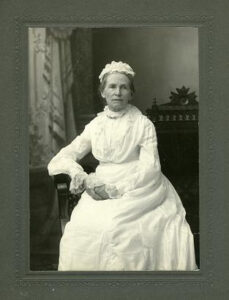
Elizabeth Koren
Part of Luther College’s beginning stages
Early Years
Else Elisabeth Hysing was born May 24, 1832 in Larvik, Norway to a distinguished, upper-class family. Although slightly deaf from childhood, this did not deter her education as she was privately tutored by teachers at her father’s school and also attended dance school. Elisabeth was married to Ulrik Vilhelm Koren on August 18, 1853. They left for America less than a month later.
Life in America
Elisabeth Koren (1832-1918) The Korens’ journey to American and their first two years in Northeast Iowa were recorded by Elisabeth Koren in her diary published in 1955. With courage and conviction, Elisabeth faced all the hardships pioneer life afforded and emerged to become the kind and accomplished mistress of the Washington Prairie parsonage until her death in 1918.
Resources in the Luther College Archives
- Koren Family — collected materials
- Luther College 1861-1961 by David T. Nelson
Works Referenced
- Nelson, David T., Luther College 1861-1961, Luther College Press, Decorah: 1961.
- Who’s Who in the Luther College Archives
External Sources
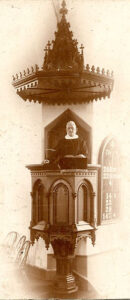
U. V. Koren
Instrumental in the founding of Luther College
Early Years
Ulrik Vilhelm Koren was born December 22, 1826 in Bergen, Norway. As a pioneer minister in American, he played a significant role in the spiritual and intellectual development of Norwegians in America. An 1852 theology graduate from the University of Christiania, he married Else Elisabeth Hysing the next year and was called to the Little Iowa Congregation in America.
Time in America
The first Norwegian minister to settle west of the Mississippi, Koren’s pastorate included large parts of Northeastern Iowa and Southern Minnesota. He played an active part in the Norwegian Synod, holding various positions from secretary in 1855 to president of the synod in 1894 until his death in 1910.
Luther College
U. V. Koren (1826-1910) U.V. Koren was also instrumental in purchasing the land and locating Luther College in Decorah, Iowa. He was been described in the Luther College Semicentennial book as a man of “wide interests, excellent scholarship, and quiet dignity” and was rewarded in 1903 for these characteristics and other achievements with a doctorate of divinity from Concordia Theological Seminary, St. Louis, Missouri, and made a Commander of the Order of St. Olaf by the King of Norway. His prominent career ended with his death on December 19, 1910, three days short of his 84th birthday.
Resources in the Luther College Archives
- Koren Family — collected materials
- Luther College 1861-1961 >by David T. Nelson
Works Referenced
- Nelson, David T., Luther College 1861-1961, Luther College Press, Decorah: 1961.
- Who’s Who in the Luther College Archives
External Resources
Professor, Interim Acting President, and College Historian (1921-1963)
Early Years
David Theodore (David T.) Nelson was born in 1891. Nelson graduated from Luther College in 1912, and he was also a Rhodes Scholar. He went to Oxford in 1914 and went on to receive a B.A. degree there. From 1914-1915, he served in Herbert Hoover’s Commission for Relief in Belgium during World War I. Following this, Nelson served in the American Ambulance Service in France from 1915-1916.
Years at Luther
In 1921, Nelson came to teach English at Luther College. In 1924 he married Esther Torrison. Torrison was the granddaughter of Elisabeth Koren and U. V. Koren, and she and Nelson were later the parents of David Torrison Nelson, a Luther physics professor. According to Jordahl and Kaasa, this meant that “she had the longest direct relationship to the college of anyone in its history” (Jordahl and Kaasa 51).
Nelson served on the Luther faculty from 1921 to 1963. He taught English and Latin, and he also coached tennis from 1922 to 1933. While at Luther, he emphasized the importance of long-range planning for the college. In addition, he established the Luther College Forensic Association, and was very involved with debate for several years. Generally liberal in his views concerning rules for students, he helped introduce coeducation and advocated allowing dancing at Luther. Along with Oivind Hovde, Nelson helped establish the senior paper requirement for graduation. He served as Business Manager in 1948 and was elected acting president in 1962, between the terms of Ylvisaker and Farwell, for one year. While president, it was decided that the new field house would be built “down the bluff,” rather than on the upper campus. The decision was controversial, but Nelson was a strong advocate of the location. Nelson translated and edited the Diary of Elisabeth Koren, translated and adapted Peer Stromme’s Halvor along with Inga B. Norstog, wrote the third chapter of Luther College Through Sixty Years: 1861-1921, entitled “Government and Administration.” Nelson is probably best remembered for his book of the history of Luther College, Luther College 1861-1961, published during Luther’s centennial year. Along with Chellis Evanson, Nelson raised money for a war memorial installed in the Main Building at Luther. Nelson retired in 1963, and he passed away in 1969.
Resources in the Luther College Archives
- David T. Nelson — collected materials
- Luther College 1861-1961 by David T. Nelson
- Stability and Change: Luther College in Its Second Century by Leigh D. Jordahl and Harris E. Kaasa
Works Referenced
- Jordahl, Leigh D. and Harris E. Kaasa, Stability and Change: Luther College in Its Second Century, Luther College Press, Decorah: 1986.
- Nelson, David T., Luther College 1861-1961, Luther College Press, Decorah: 1961.
- Papers of David T. Nelson
- Who’s Who in the Luther College Archives
External Resources
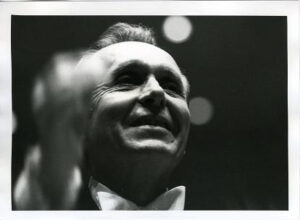
Weston Noble
Music department faculty member (1948-2005)
Early Years
Weston Henry (Weston H.) Noble was born on November 30, 1922 in Riceville, Iowa. His parents were Merwin and Ruth (Lappin) Noble. He started taking piano lessons when he was five years old.
Years at Luther
Weston Noble was one of the most influential people in the history of music at Luther College. He first came to Luther as a student in 1939 at the age of 16. He was a member of both Concert Band and Schola Cantorum. Majoring in music education and history, he graduated early in 1943 to join the Army Enlisted Reserve Corps and fight in World War II.
Upon his return to the United States in 1946, Noble debated the possibility of pursuing a graduate degree in music. At the last minute, he decided to postpone his further education and turned to teaching high school music. He received a job at the high school in LuVerne, Iowa, and began teaching there in the fall of 1946. He spent two years at LuVerne before joining the Luther faculty on a “temporary” basis in 1948. The summer before Noble returned to Luther, he began his graduate studies at the University of Michigan. In the fall, Noble was asked if he would fill in for one year until a replacement was found for a recently resigned member of the music faculty. He agreed, and again put his graduate studies on hold. In 1948, Noble became a member of the Luther College faculty, and began his direction of the Concert Band and Nordic (Cathedral) Choir, as well as conducting annual performances of Handel’s Messiah. Because of his success in these endeavors, Noble was asked to stay another year, thus beginning his legacy at Luther College. He attended 9 years of summer school classes at the University of Michigan, 1947-1955, and completed his master’s degree there in 1951. He began the Dorian Music Festival in 1950, and became head of the music department by 1953. Noble relinquished direction of the Concert Band in 1973. He served as director of the Nordic Choir until his retirement in 2005.
After Luther
Noble continued to recruit new students to Luther and served as a guest conductor across the nation. He passed away in December 2016.
Other Information
By 1965, Noble began to be bothered by the amount of litter on the Luther College campus. By 1982 he was devoted to picking up campus trash. He became well-known for his dedication to keeping up the campus grounds.
Noble received numerous honors over the course of his years at Luther. Among the most notable are: Carlo A. Sperati Award in 1961; Honorary Doctor of the Arts Degree from Augustana College, Sioux Falls, South Dakota in 1971; first to be named Outstanding Music Educator of the United States in 1989; first recipient of the Weston H. Noble Award in 1994; and Honorary Degree of Doctor of Fine Arts from St. Olaf College, Northfield, Minnesota in 1996.
The Weston Noble papers collection is arranged into ten series: Series I, Correspondence; Series II, Tours; Series III, Guest Conducting; Series IV, Awards/Honorary Degrees; Series V, Writings About/Dissertations; Series VI, Photographs; Series VII, Realia; Series VIII, Audio Visual; Series IX, Yearbooks; and Series X, Scrapbooks.
Resources in the Luther College Archives
- Luther College 1861-1961 by David T. Nelson
- Stability and Change: Luther College in Its Second Century by Leigh D. Jordahl and Harris E. Kaasa
- Warmly Weston: A Luther College Life by Wilfred F. Bunge
- Weston H. Noble — collected materials
Works Referenced
- Bunge, Wilfred F., Warmly Weston: A Luther College Life, Luther College Press, Decorah: 1998.
- Jordahl, Leigh D. and Harris E. Kaasa, Stability and Change: Luther College in Its Second Century, Luther College Press, Decorah: 1986.
- Nelson, David T., Luther College 1861-1961, Luther College Press, Decorah: 1961.
- Papers of Weston Noble
- Who’s Who in the Luther College Archives
External Resources
First curator and director of the Norwegian-American Historical Museum (1947-1960)
Early Years
Inga Bredesen Norstog was born in 1885.
Years at Luther
Inga Bredesen Norstog (1885-1960) As the first curator and director of the Norwegian-American Historical Museum, Norstog became part of the Luther College faculty in 1947. During her 13 years in this position, she made numerous improvements to the museum’s displays, and was highly successful in increasing its publicity. Norstog was director of the Norwegian-American museum until shortly before her death in 1960. In addition, she worked together with David T. Nelson to translate Peer Stromme’s Halvor from Norwegian to English. Jordahl and Kaasa refer to Halvor as a “charming novel of the experiences of an early-day Luther student” (Jordahl and Kaasa 23). Norstag translated other important documents from Norwegian which are located in the Luther College archives.
Resources in the Luther College Archives
- Luther College 1861-1961 by David T. Nelson
- Stability and Change: Luther College in Its Second Century by Leigh D. Jordahl and Harris E. Kaasa
Works Referenced
- Jordahl, Leigh D. and Harris E. Kaasa, Stability and Change: Luther College in Its Second Century, Luther College Press, Decorah: 1986.
- Nelson, David T., Luther College 1861-1961, Luther College Press, Decorah: 1961.
- Who’s Who in the Luther College Archives
External Resources
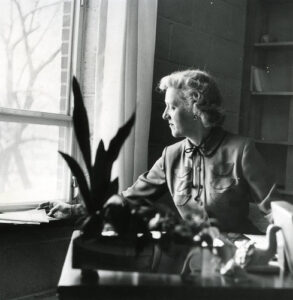
Clara Paulson
One of the first female faculty members (1939-1971)
Early Years
Clara J. Paulson was born on June 10, 1907 in Buxton, North Dakota. She attended Buxton High School and was a 1930 graduate of Concordia College where she graduated summa cum laude. Paulson served as the assistant dean of women at Concordia from 1930-1935 and again in 1937-1939. She was a student dean at Syracuse University from 1935-1937, where she graduated with her master’s of arts degree in 1937.
Years at Luther
Clara Paulson was an English faculty member at Luther from 1939 until 1971.
Paulson was the first woman to receive tenure and move up through the ranks to full professor. Paulson served as the Dean of Women from 1940-1947. Paulson was a Fulbright Exchange Teacher to Bergen, Norway in 1950-1951.
She established Luther’s chapter of the American Association of University Women and student organizations for women. Paulson was repeatedly described as being instrumental in defining the place of women on the campus. In 1964, she was initiated into Iowa Upsilon, the state chapter of the Delta Kappa Gamma Society, an international honor society for women educators.
She offered Luther’s first regular African American studies course, Black Expression in Literature. She attended the Northwestern University 1969 summer workshop on “Race and Class in an Urban Context,” a workshop partially funded by the National Endowment for the Humanities and the Ford Foundation. The purpose of the workshop was “to help college teachers in American literature, history, civics, social science, and the humanities to strengthen existing courses and to prepare new courses stressing the historical context of American race relations and the impact of urbanization on black Americans and on their position in the class structure.” (Center for Urban Affairs)
After Luther
Upon retirement, Paulson moved to northern Minnesota. She was awarded the title of Professor Emeritus. In October 1976, she was awarded the Alumni Achievement Award from Concordia College. Paulson died April 14, 1977.
Resources in the Luther College Archives
- Clara Paulson — collected materials
- Luther College 1861-1961 by David T. Nelson
- Stability and Change: Luther College in Its Second Century by Leigh D. Jordahl and Harris E. Kaasa
Works Referenced
- Jordahl, Leigh D. and Harris E. Kaasa, Stability and Change: Luther College in Its Second Century, Luther College Press, Decorah: 1986.
- Nelson, David T., Luther College 1861-1961, Luther College Press, Decorah: 1961.
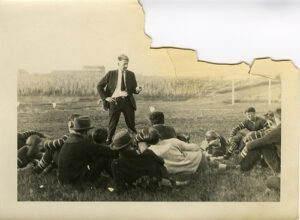
Hamlet Peterson
Strong role in Luther College athletics and coaching (1922-1967)
Early Years
Hamlet Peterson was born in 1897.
Years at Luther
Hamlet Peterson (1897-1973), or Coach Pete, is renowned for his role in Luther College athletics. He entered Luther as a student in 1916, but his education was interrupted by his service as a lieutenant in the American Expeditionary Force during World War I. A 1922 graduate, Peterson was asked to teach in Luther’s preparatory department upon his graduation. By 1925, he was coach of the football, basketball and track teams, and later added baseball to the list. He taught both physical education and classical languages in addition to coaching. A member of the Luther faculty from 1922 to his retirement in 1967, he coached football and basketball through 40 seasons. In March of 1958 he was elected to the Hall of Fame (basketball section) of the National Association of Intercollegiate Athletics. In his 1972 book, The Noble Norsemen, Peterson narrated the story of Luther College athletics through the 1960s. Peterson passed away in 1973.
Resources in the Luther College Archives
- Luther College 1861-1961 by David T. Nelson
- Stability and Change: Luther College in Its Second Century by Leigh D. Jordahl and Harris E. Kaasa
Works Referenced
- Jordahl, Leigh D. and Harris E. Kaasa, Stability and Change: Luther College in Its Second Century, Luther College Press, Decorah: 1986.
- Nelson, David T., Luther College 1861-1961, Luther College Press, Decorah: 1961.
- Who’s Who in the Luther College Archives
External Resources
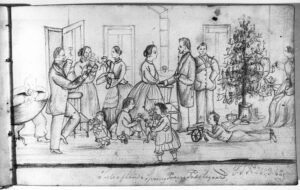
Linka Preus, family, and friends
A voice from the early stages of Luther College
Early Years
Caroline Dorothea Margrethe (Linka) Keyser was born in 1829 in Kristiansand, Norway. Linka and her husband, Herman Amberg Preus, arrived in Spring Prairie, Wisconsin in 1851.
Years at Luther
Linka Preus’s (1829-1880) husband was a pastor and later the president of the Norwegian Lutheran Synod in America. Christian Keyser Preus, her son, became the second president of Luther College. Linka is best remembered for her sketchbooks which contain her drawings of Luther College and the Decorah area from the 1850s and 1860s. In 1876, she suffered a stroke from which she never fully recovered. She died four years later in 1880. Her diary, translated in 1951, contains details not only about events in her life but also about her thoughts and feelings in entries recorded from 1844 to 1864.
Other Information
Linka’s sketches depict moments relating to Luther College as well as to the Midwest and her native Norway, respectively.
The Linka Preus papers collection includes correspondence, sketches, and her diary.
Linka’s diary was recently translated and edited by Marv Slind and Gracia Grindal. Slind and Grindal also incorporated some of Linka’s sketches.
Resources in the Luther College Archives
- Caroline (Linka) Keyser Preus — collected materials
- Luther College 1861-1961 by David T. Nelson
Works Referenced
- Nelson, David T., Luther College 1861-1961, Luther College Press, Decorah: 1961.
- Who’s Who in the Luther College Archives
External Resources
Member of faculty and administration (1918-1969)
Early Years
Orlando (Pip) W. Qualley was born in 1897.
Years at Luther
Orlando (Pip) W. Qualley (1897-1988), a member of the Luther College class of 1918, became part of both the faculty and the administration at Luther between his graduation in 1918 and his retirement in 1969. During his years of service to Luther, he held positions of Vice President, Dean, Professor of Classical Languages, Registrar, basketball coach and football coach. Qualley was the first to hold the position of Dean, serving from 1946-1964. He was also the first Luther Vice President, a position to which he was appointed in 1936. He was Registrar for two periods, first from 1942 to 1946, and again from 1950 to 1956. Qualley worked especially closely with President J. Wilhelm Ylvisaker to assert direction and policy for the college. Often described as a workaholic, he was known for his firmness, directness and drive. He encouraged high academic standards, and recruited a faculty devoted to education. After he stepped down from the office of Dean he returned to teaching for five years before retiring. Qualley passed away in 1988.
Other Information
The first endowed faculty chair at Luther College is named for Qualley.
William P. Sihler gave Qualley the nickname of “Pip” because that was “the name of the small but strong mediaeval king, Pippin the Short” (Jordahl and Kaasa 57).
Resources in the Luther College Archives
- Luther College 1861-1961 by David T. Nelson
- O. W. Qualley — collected materials
- Stability and Change: Luther College in Its Second Century by Leigh D. Jordahl and Harris E. Kaasa
Works Referenced
- Jordahl, Leigh D. and Harris E. Kaasa, Stability and Change: Luther College in Its Second Century, Luther College Press, Decorah: 1986.
- Nelson, David T., Luther College 1861-1961, Luther College Press, Decorah: 1961.
- Who’s Who in the Luther College Archives
External Resources
Member of the faculty and curator of the Norwegian-American museum (1890-1940)
Early Years
William P. Sihler was born on November 5, 1865 to Wilhelm and Susanna Kern Sihler. He attended college at Concordia College in Fort Wayne, Indiana. Sihler graduated from Concordia Theological Seminary at the age of 21, but “because he considered himself too young to become an ordained minister, unlike many of his classmates he did not enter active ministry” (Nervig 4). He earned his masters degree from the University of Wisconsin in 1888.
Sihler married Amalia Carolina Schust, his childhood sweetheart, in Fort Wayne on June 23, 1892. They had four children.
Years at Luther
William P. (Billy) Sihler (1865-1941), a member of the Missouri Synod, was part of the Luther College faculty from 1890 to 1940. Although he primarily taught German, he also taught a wide variety of other subjects over the course of his tenure at Luther, including geography, religion, history, Greek, Latin, French, gymnastics, penmanship, music, and zoology. Known to most people as “Billy,” he also helped prepare the first tennis court at Luther. His experience playing professional baseball helped to promote the development of the game at Luther. From 1890 to 1895, Sihler served as the organizer and conductor of musical ensembles and during those same years was curator of the Norwegian-American museum. He authored the first chapter of Luther College Through Sixty Years: 1861-1921 entitled “The Foundation of Luther College.” Sihler passed away in July 1941.
Other Information
Sihler gave O. W. Qualley the nickname of “Pip” because that was “the name of the small but strong mediaeval king, Pippin the Short” (Jordahl and Kaasa 57).
Resources in the Luther College Archives
- Luther College 1861-1961 by David T. Nelson
- Stability and Change: Luther College in Its Second Century by Leigh D. Jordahl and Harris E. Kaasa
- The Provocative Professor: The Billy Sihler Stories by Roland A. Nervig
- William Paul Sihler — collected materials
Works Referenced
- Jordahl, Leigh D. and Harris E. Kaasa, Stability and Change: Luther College in Its Second Century, Luther College Press, Decorah: 1986.
- Nelson, David T., Luther College 1861-1961, Luther College Press, Decorah: 1961.
- Nervig, Roland A., The Provocative Professor: The Billy Sihler Stories, Luther College Press, Decorah: 1992.
- Who’s Who in the Luther College Archives
External Resources
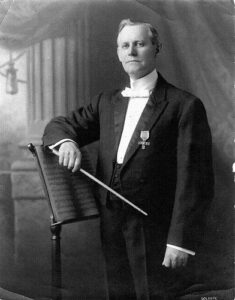
Carlo A. Sperati
Music department director and faculty member (1905-1943)
Early Years
Carlo Alberto Sperati (Carlo A.) was born to Italian musician Paolo Agostino Sperati and Marie (Nielsen) Sperati on December 29, 1860; he was their eighth child. His mother died when he was five and his father then married Mathilde Bendixsen. Sperati started taking music lessons and performing at an early age. When Sperati was seventeen, his father consented to let him go to sea, which was something Sperati had been yearning to do since he was a young boy. After a few years at sea, Sperati came to Luther College to study Theology in the summer of 1884. He found out about Luther through the Seaman’s Mission in Brooklyn, New York. Luther’s first president, Laur Larsen, had established the mission in 1860.
Years at Luther
While at Luther, Sperati was a member of the Orchestra and the Concert Band. In addition, he formed a singing group called Lorelei. During his second year, Sperati joined the faculty part-time as a singing instructor. Sperati is best known for his development of the Luther College Concert Band. He was a Luther student from 1884 to 1888. While a Luther student, he organized the Turning Club in 1886. In 1887 Sperati became engaged to Emma Hoffoss, who lived in Decorah, when he was twenty-six and she was sixteen. The following year Sperati graduated from Luther and Emma Hoffoss graduated from high school. After his graduation from Luther, he attended Luther Seminary in St. Paul, Minnesota. Sperati and Emma Hoffoss were married on August 25, 1891 at First Lutheran Church in Decorah, Iowa. Directly after the wedding they traveled to Whatcom County, Washington where Sperati served as pastor to the local Lutheran congregation. In the fall of 1894, Sperati and his wife both became faculty members at Pacific Lutheran University. Sperati taught music and voice and Mrs. Sperati taught at the Primary School. During this time Sperati also served as a Pastor in Tacoma, Washington. In 1905, Sperati became the musical director at Luther College, where he remained until he retired in 1943. While a member of the Luther faculty, he also taught religion classes, but was most well-known for his music activities. He led the Concert Band on extended European tours, and helping it win international acclaim. He also directed performances of Handel’s Messiah. Sperati was known for his strict discipline, demand for perfection, and patience when working with music students. The Speratis had a total of eight children. Sperati retired from directing the Luther College Concert Band after thirty-eight years in 1943. Sperati died on September 12, 1945 at home in Decorah at age eighty-four. Mrs. Sperati continued living at 501 High Street until her failing health made it necessary for her to move to a nursing home, where she died on February 5, 1952.
Other Information
The Sperati family papers consist of 6 series: Series I, Correspondence; Series II, As Faculty at Luther College; Series III, Awards, Honors and Memorials; Series IV, Scrapbooks; Series V, Emma Hoffoss Sperati; and Series VI, Realia.
The first series in the Sperati family papers, Correspondence, comprises the majority of the collection. The series is arranged starting with the correspondence between Carlo A. Sperati and his wife Emma Hoffoss Sperati. First in the series is correspondence to Emma Hoffoss Sperati from Carlo A. Sperati from 1887-1891. Next in the series is correspondence from Emma Hoffoss Sperati to Carlo A. Sperati from 1888-1891. Finishing out the series is correspondence to Carlo A. Sperati from friends and family dating from 1882-1939.
Resources in the Luther College Archives
- Carlo A. Sperati and family — collected materials
- Carlo A. Sperati: The Grand Old Maestro by Camilla Sperati Strom
- Luther College 1861-1961 by David T. Nelson
- Stability and Change: Luther College in Its Second Century by Leigh D. Jordahl and Harris E. Kaasa
Works Referenced
- Jordahl, Leigh D. and Harris E. Kaasa, Stability and Change: Luther College in Its Second Century, Luther College Press, Decorah: 1986.
- Nelson, David T., Luther College 1861-1961, Luther College Press, Decorah: 1961.
- Papers of Carlo A. Sperati and family
- Strom, Camilla Sperati, Carlo A. Sperati: The Grand Old Maestro, Luther College Press, Decorah: 1988.
- Who’s Who in the Luther College Archives
External Resources
Search the Archives
Contact Information
Hayley Jackson
College Archivist Librarian
John Werner
Processing Archivist
Preus Library 310
Upper Floor
Luther College
700 College Drive
The Archives is open for research from 1:00-4:30, Monday-Friday, and by appointment.
archives@luther.eduPhone: 563-387-1805